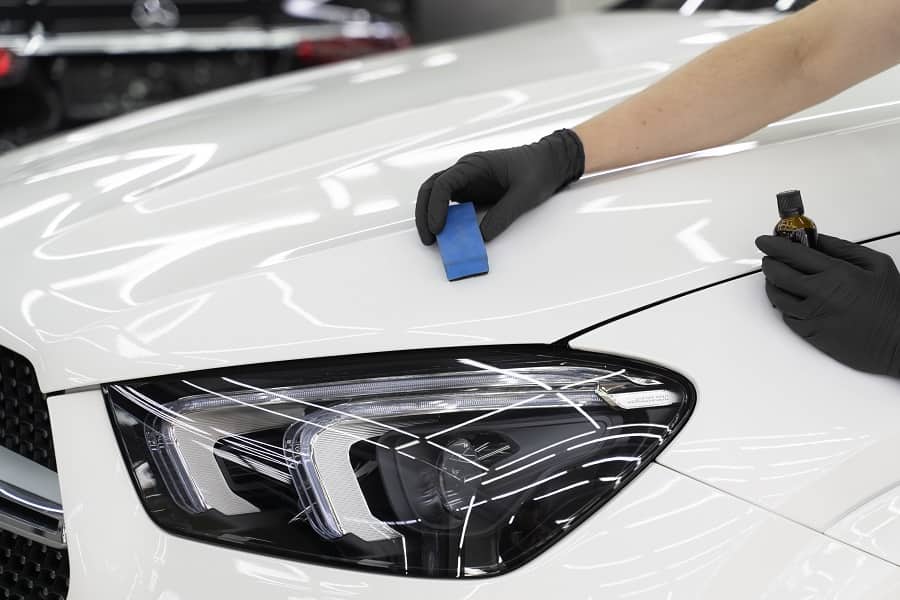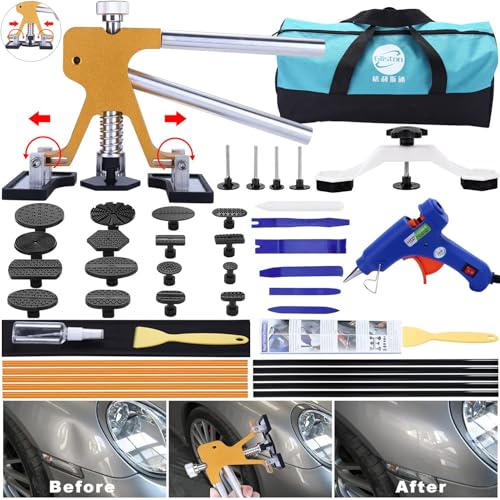You can quickly fix minor vehicle dents at home with the correct tools and DIY abilities. Below, this helpful guide contains a list of available PDR tools online. In addition, we will explore their benefits and how to use them for dent repair effectively.
Essential PDR Tools
Regarding Paintless Dent Repair (PDR), specific tools are indispensable for achieving excellent results. Let’s explore the essential tools used in the PDR process:
A. Dent Removal Rods and Hooks
Dent removal rods and hooks are the backbones of PDR, allowing technicians to precisely manipulate dents from the inside of the vehicle’s panels. These tools provide the necessary leverage and control to restore the original shape of the dent gradually.
Key features:
- Different rod and hook shapes for versatility
- Made of durable and flexible materials
- Designed to reach tight spaces
B. Dent Glue Pulling Kit
Glue-pulling kits are another valuable tool in the PDR arsenal. These kits involve the application of adhesive tabs to the dent, then gently pulling the dent out using specialized tools. Glue pulling is particularly effective for shallow dents and areas where accessing the backside is challenging.
Key features:
- Adhesive tabs with a firm grip
- Pulling tools with ergonomic handles
- Safe for the vehicle’s paint finish
C. Dent Repair LED Light
Dent repair lights play a crucial role in assessing and effectively repairing dents. These lights provide optimal illumination, enabling technicians to visualize the dent’s size, depth, and contours accurately. With the aid of dent repair lights, technicians can precisely apply pressure and monitor the progress of the repair.
Key features:
- Bright and adjustable lighting
- Different light color options
- Portable and easy to position
D. Dent Reflector Board
Dent reflector boards are used with dent repair lights to enhance visibility and aid in dent assessment. These boards create contrast and reflections that help technicians identify the exact shape and contours of the dent, allowing for more accurate repairs.
Key features:
- Reflective surface for enhanced visibility
- Lightweight and easy to handle
In summary, the essential PDR tools include dent removal rods and hooks for precise manipulation, glue-pulling kits for effective dent removal, dent repair lights for accurate assessment, and reflector boards for enhanced visibility. These tools work together to ensure efficient and professional dent repair results, helping to restore your vehicle’s flawless appearance.
Related Tool to remove lug nuts
For more on tool to remove lug nuts read the full article.
Master Dent Repair: PDR Tools 101
A. Importance of Addressing Dents in Cars
Repairing car dents is vital for preserving their look and resale worth. Even minor dents can diminish the overall beauty and create a perception of neglect. It’s crucial to promptly and efficiently handle these dents.
B. Introduction to PDR Tools
PDR (Paintless Dent Repair) tools offer a reliable and cost-effective solution for fixing car dents. Unlike traditional methods that involve repainting, PDR tools enable dent removal without compromising the original paint finish. They are designed to provide efficient and professional dent repair results, making them a preferred choice for many car owners.
PDR Tools: An Overview
A. Explanation of PDR (Paintless Dent Repair) Technique
Fixing car dents has always been challenging with the game-changing Paintless Dent Repair (PDR) technique. This non-invasive approach restores dented surfaces without repainting. Here’s how it works:
- Accessing the Dent: PDR technicians gain access to the backside of the dent, allowing them to work directly on the affected area.
- Precision Manipulation: Using specialized tools, such as dent removal rods and hooks, technicians carefully apply pressure to the dent, gradually pushing it back to its original shape.
- Malleability Enhancement: Heat guns may soften the metal surrounding the dent, making it more pliable and easier to manipulate.
- Visual Assessment: Dent repair lights and reflective boards help technicians accurately assess the dent’s size, depth, and contours, ensuring precise repairs.
B. Advantages of Using PDR Tools
PDR tools offer numerous advantages over traditional dent repair methods. Here are some key benefits of using PDR tools for dent repair:
- Cost-Effective: PDR eliminates the need for repainting, resulting in significant cost savings compared to conventional repair techniques.
- Time-Saving: PDR is generally faster than traditional methods, reducing your vehicle’s time in the repair shop.
- Preserves Original Paint: By protecting the original paint finish, PDR maintains the integrity and value of your vehicle.
- Environmentally Friendly: PDR tools offer a sustainable solution that actively avoids the use of harmful chemicals and actively reduces waste associated with repainting.
In summary, PDR is a highly effective technique for repairing car dents without repainting. It involves accessing the dent, manipulating it with specialized tools, and utilizing visual aids for accurate assessment. The advantages of using PDR tools include cost savings, time efficiency, paint preservation, and environmental friendliness. With PDR tools, you can restore your vehicle’s flawless appearance cost-effectively and eco-friendly.
Using PDR Tools: Step-by-Step Guide
Using PDR tools effectively requires a systematic approach. Follow these steps for successful dent repair:
A. Assessing the Dent
Start by assessing the dent’s size, depth, and contours. This step helps you understand the complexity of the repair and choose the appropriate PDR techniques and tools.
Key steps:
- Examine the dent from different angles and lighting conditions.
- Measure the dent’s diameter and depth using a dent repair gauge.
- Take note of any additional damage or paint chips around the dent.
B. Preparing the Area
Preparing the area around the dent sets the stage for a successful repair. Proper preparation ensures a clean and accessible workspace.
Key steps:
- Clean the dent and surrounding area using a mild detergent and microfiber cloth.
- Remove any loose debris or wax buildup using a plastic trim tool.
- Mask off adjacent panels with painter’s tape to protect them during the repair.
C. Applying PDR Techniques
With the dent assessed and the area prepared, it’s time to apply the PDR techniques using the appropriate tools.
Key steps:
- Choose the suitable PDR tool based on the dent’s location, size, and accessibility.
- Position the tool behind the dent and apply controlled pressure in the opposite direction.
- Gradually work the dent back to its original shape using pushing and tapping motions.
- If necessary, use heat guns to warm the metal for greater malleability.
D. Checking Progress with Dent Repair Lights
Regularly checking your progress ensures you stay on the right track and accomplish the desired results. Dent repair lights help you identify imperfections and make necessary adjustments.
Key steps:
- Position the dent repair light to provide optimal illumination of the repair area.
- Inspect the dent under the light to check for any remaining imperfections or high spots.
- Make additional adjustments, if needed, using the appropriate PDR tools.
In summary, using PDR tools involves assessing the dent, preparing the area, applying PDR techniques, and checking progress with dent repair lights. By following these steps, you can confidently repair dents systematically and effectively, achieving professional-grade results on your vehicle.
Tips for Successful Dent Repair
Attention to detail and applying valuable tips are crucial to achieving successful dent repair. Here are some practical suggestions to help you achieve excellent results:
A. Applying the Right Amount of Pressure
Finding the right balance and applying precise pressure are crucial for successful dent repair. Avoiding additional surface damage is critical.
Tips:
- Start with gentle pressure and gradually increase as needed.
- Pay attention to the response of the dent to adjust the pressure accordingly.
- Use the appropriate PDR tool to apply precise and controlled pressure.
B. Being Patient and Persistent
Patience and persistence are virtues when it comes to dent repair. Some dents may require multiple attempts and adjustments before achieving the desired outcome.
Tips:
- Work methodically and take your time to avoid rushing the repair process.
- Persist, and only let discouragement set in if you see immediate results.
- Evaluate progress along the way by making minor adjustments.
C. Practicing on Smaller Dents First
If you’re new to dent repair, practicing on more minor dents can build confidence and enhance your skills before tackling more extensive, complex repairs.
Tips:
- Start with dents that are easier to access and repair.
- Practice different PDR techniques on more minor dents to refine your skills.
- Gain experience and gradually move on to larger dents as you become more proficient.
In summary, successful dent repair requires applying the right amount of pressure, being patient and persistent throughout the process, and starting with more minor dents to practice and build your skills. Following these tips can improve your dent repair abilities and achieve impressive results.
When to Seek Professional Help
Seeking professional help for dent repair at the right time is crucial for achieving the best results. Consider these factors:
A. Recognizing Complex or Severe Dent Damage
Certain types of damage may require the expertise of a professional. Recognizing complex or severe damage helps you make an informed decision about seeking professional assistance.
Indications of complex or severe dent damage:
- Deep, sharp creases or folds in the metal
- Paint damage or chipping around the dent
- Damage extending to multiple panels or areas
- Structural damage affecting the vehicle’s integrity
- Complex dents in hard-to-reach areas
B. Knowing When DIY Methods May Not Be Sufficient
While DIY methods can be effective for many minor dents, there are situations where professional intervention is necessary. Knowing the limitations of DIY methods helps you determine when it’s time to consult a professional.
Instances when DIY methods may not be sufficient:
- Lack of access to specialized PDR tools and equipment
- Limited experience or skills in dent repair techniques
- Lack of confidence in handling complex repairs
- Time constraints or limited availability to dedicate to the repair
- Safety concerns or uncertainty about potential risks
In summary, it’s essential to recognize complex or severe damage and understand the limitations of DIY methods. Seeking professional help is advisable when dealing with intricate damage or when DIY methods may not yield satisfactory results. Consulting a professional ensures your vehicle receives the expertise and attention it needs for optimal dent repair outcomes.
Conclusion
As we conclude our exploration of PDR (Paintless Dent Repair) tools, let’s recap their effectiveness and encourage you to tackle minor dents using these tools confidently.
A. Recap of PDR Tools and Their Effectiveness
Throughout this guide, we’ve learned about the effectiveness of PDR tools in repairing minor dents. Here’s a quick recap:
- Dent Removal Rods and Hooks: These versatile tools provide precise manipulation from the inside, allowing you to restore the dent’s shape gradually.
- Dent Glue-Pulling Kit: Using glue-pulling kits effectively removes shallow dents and those in hard-to-reach areas.
- Dent Repair Light: These lights provide optimal illumination for accurate assessment and progress monitoring during the repair process.
- Dent Reflector Board: Paired with dent repair lights, dent reflector boards enhance visibility and aid in identifying dent contours for more precise repairs.
B. Encouragement to Tackle Minor Dents Confidently Using PDR Tools
Knowing PDR tools and techniques, you can confidently tackle minor dents independently. Here’s why:
- Save Money with PDR Tools: They offer a cost-effective solution compared to traditional dent repair methods that require repainting.
- Convenience: Enjoy the convenience of repairing minor dents at home on your schedule and at your own pace.
- Satisfaction and Pride: Feel accomplished and proud of your DIY skills when you successfully repair minor dents using PDR tools.
You’ll see your skills grow as you keep practicing. If you run into some severe or complicated dent damage, don’t hesitate to contact the pros for their expert help.





